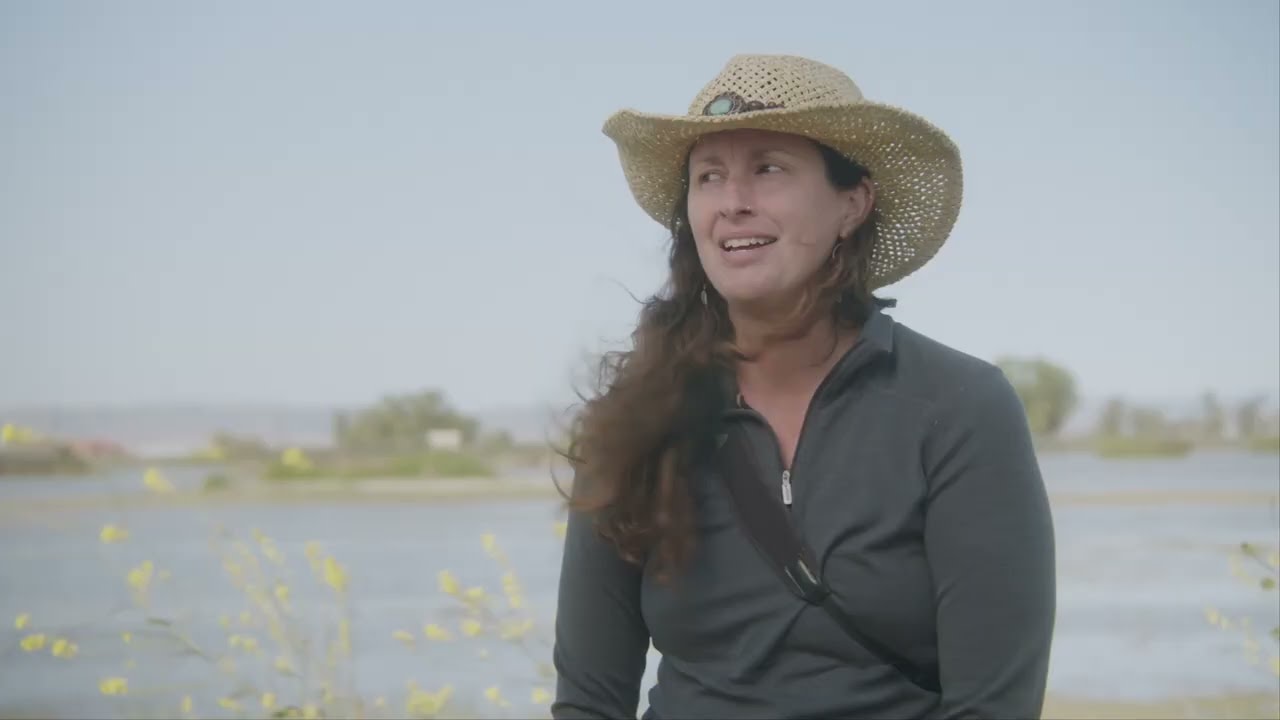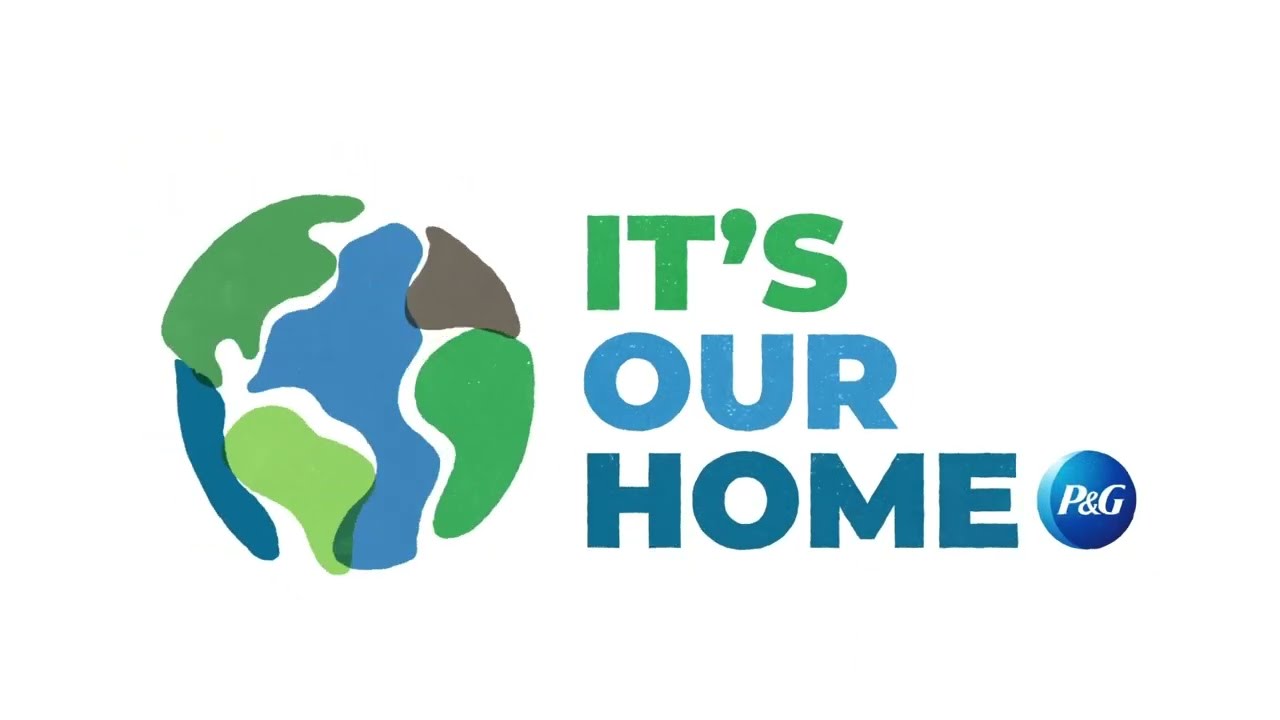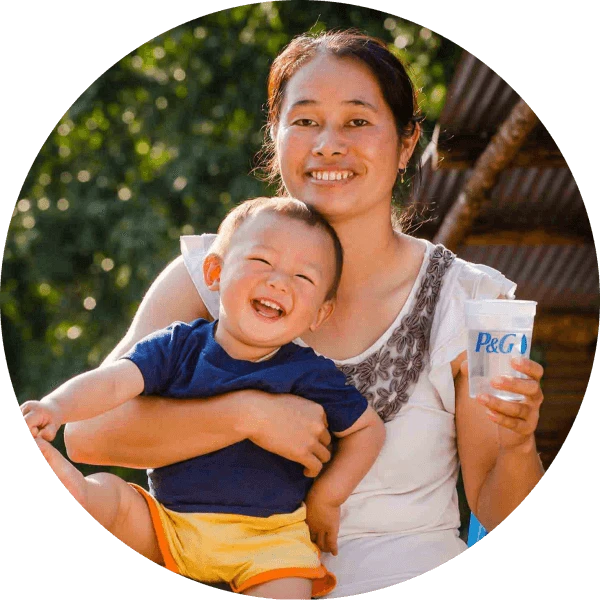2022-06-10
A Closer Look at P&G’s New Strategy to Help Address Global Water Crisis
In June 2022, P&G announced a strategy to help build a water positive future that includes restoring water in 18 water-stressed areas around the world for people and nature, responding to water challenges through innovation and partnerships, and reducing water in our operations. This comprehensive effort includes a global portfolio of water restoration projects that will provide a range of solutions to protect ecosystems, replenish groundwater supplies, reduce the amount of water diverted from essential bodies of water, and improve water quality for the community and the wildlife that depends on them.
As part of this strategy, P&G has added two new goals to its comprehensive program:
- Making of our products: Restore more water than is consumed1 at P&G manufacturing sites located in 18 water-stressed areas around the world.
- Use of our products: Restore more water than is consumed2 when using P&G products in the high water-stressed metropolitan areas of Los Angeles and Mexico City – recognized as a first-of-its-kind commitment.
We will achieve these goals through partnerships with organizations and restoration projects that improve, manage, and protect water resources.
But what exactly does it all mean? Let’s break it down:
Why is P&G taking action?
By 2025, the United Nations projects that about two-thirds of people on the planet will live in water-stressed areas. Water is critical for people, essential to support nature, wildlife, and agriculture. It's also important for making all and using most of P&G’s products (e.g., shampoo, laundry detergent, dish soap etc.). That’s why we are building on our water progress with additional goals and partnerships so we can be part of a ripple effect toward a water positive future.
Building A Water Positive Future: The Scoop on Our Strategy
What do you mean by a “water positive future?”
To P&G, a water positive future is one where water can sustain people and nature, now and for generations to come. We will contribute toward this future by restoring water in water-stressed areas, responding to water challenges through innovation and partnerships, and reducing water in our operations. This is a future that cannot be achieved alone, and partnership is critical to making a positive impact.
Where will you be restoring the water in your new goals?
Our intent is to restore the volume of water consumed from each of the water-stressed basins back to those respective basins through long-term projects that improve, manage, and protect water resources.
How do you define water “consumed” in your new goals?
During the manufacturing of our products, water consumed is the amount that evaporates or is included as a product ingredient. For consumers, we define water consumed as coming from common household leaks and evaporation that occurs during the use of our products. In general, this is the portion of water that does not go back to the local basin for further beneficial use (e.g., water that does not return to the local supply through drains, pipes, channels, etc.).
When people use products to wash their hair, shave, do their laundry, etc. some of that water can evaporate or is consumed by common leaks in homes. Our new goals and projects focus on addressing the water that does not go back to local systems from our operations and, for the first time in our industry, from consumer use of products.
Water Consumed
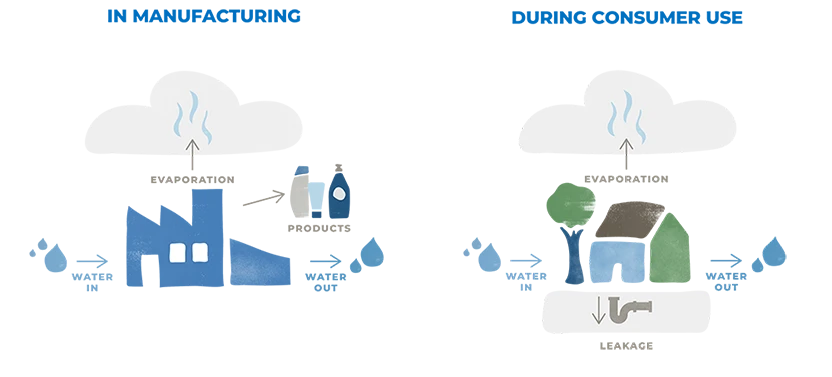
How did P&G identify and prioritize these water-stressed areas?
Recognizing that water stress and scarcity are increasing in many regions around the world, we conducted a detailed water risk assessment with expert partners at World Resources Institute (WRI), World Wildlife Fund (WWF), and Environmental Resources Management (ERM).
This approach helped us pinpoint 18 water-stressed areas across seven countries, known as water basins. The priority basin names and boundaries come from the World Resources Institute (WRI) Aqueduct 3.0 dataset. Each of these basins meets three criteria, including: underlying chronic water stress; they contain at least one P&G manufacturing facility; and are located within a priority P&G market.
Our 18 water-stressed areas include:
- United States – Lower American, Calleguas, Lower Bear-Malad, Lower Salt
- Mexico – Moctezuma, Laja, Lerma-Salamanca
- Spain – Segura
- Italy – Garigliano
- Turkey – Kocaeli
- India – Sabarmati, Sutlej, Yamuna 1, Jamni, Musi-Aler
- China – Xuanhui He, Hai He Delta, Tuo Jiang
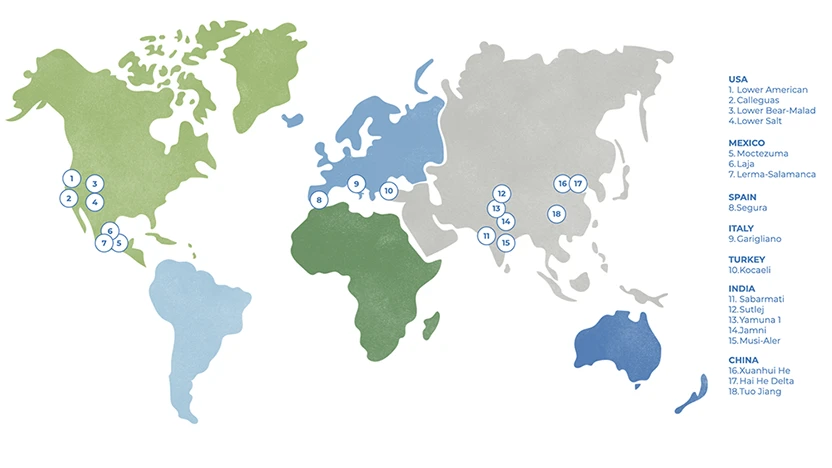
How did P&G choose these goals? What is the methodology behind them?
We first determined the amount of water we use when making products and the amount of water people use with our products. We learned much of the water used when making our products returns to the local basin, while the rest evaporates or is used as a product ingredient.
We worked closely with the World Resources Institute (WRI) Water Program to ensure our new water targets align with the best science and emerging target-setting practices. We knew from the beginning that we wanted to develop goals that not only address the water consumed during manufacturing but also address water consumed during the use of our products, as consumer use accounts for the majority of P&G’s overall water footprint.
To directly address the water associated with consumer use of P&G products, we first needed to understand the approximate water volumes that do not go down the drain and back to our priority basins after product use. We worked with the World Resources Institute (WRI) to develop a new approach to estimate the annual water consumed2 when consumers use P&G products in our 18 priority areas. The details of the method used to derive our new goals is planned for publication with WRI in August 2022.
Why did P&G set specific goals for restoring water consumed from consumer use of products for metropolitan Los Angeles and Mexico City?
After comparing the volumes of all 18 priority basins, we found that the basins in and near Los Angeles and Mexico City account for over half of the water consumed from the use of P&G products across all priority basins. The details of the method used to derive our consumer use target are planned for publication with WRI in August 2022.
How much water is consumed during the use of P&G products in the priority basins?
Working closely with the World Resources Institute (WRI), we determined roughly 9%-17% of water is consumed during the use of P&G products in priority basins through evaporation or common household leaks. More information on these estimates will be provided in the upcoming publication with WRI.
Restoring Water in Water-Stressed Areas for People and Nature
To restore water in water-stressed areas, we are working with on-the-ground partners who have a deep knowledge of local challenges, solutions, communities, and landscapes to support long-term projects that improve, manage, and protect water resources.
These projects can include a range of solutions such as managing wetlands, reforesting land, improving irrigation systems, using sensors to identify and stop leaks, and supporting transformational conservation programs. Together, they are helping to protect ecosystems, recharge groundwater supplies, reduce the amount of water diverted from essential bodies of water, and improve water quality for the communities and wildlife that depend on it.
What projects are already underway?
We are already advancing projects that are restoring water resources in critical areas of the U.S. in California and Arizona in partnership with the Bonneville Environmental Foundation (BEF). These projects include creating habitat for migratory bird species, helping to replenish groundwater levels, and restoring forestland to reduce the risk of wildfires.
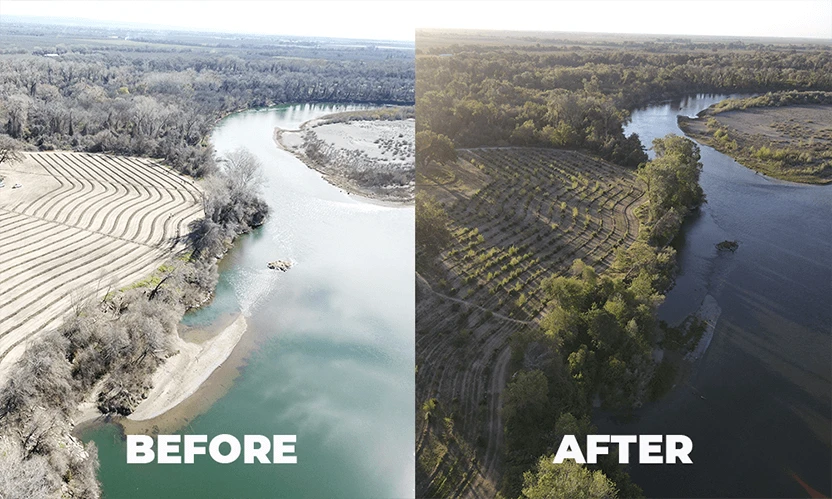
Before photo courtesy of Alex Karolyi
BRAYTON RESTORATION PROJECT, California, U.S.
Restoring 25 acres of land back to native habitat and improving water quality along the Sacramento River.

Before photo courtesy of Chico State Enterprises
EAST SAND SLOUGH SIDE CHANNEL RECONNECTION PROJECT, California, U.S.
Creating a sustainable habitat for critically endangered juvenile Chinook salmon and other species by allowing water to flow for more days out of the year.
What new projects is P&G supporting?
In June, we announced the support of six new projects in the Bear River Basin in Utah and Idaho in partnership with BEF. These include projects that will restore natural habitat, improve water quality, preserve cultural history, and enhance irrigation efficiency for local communities and important wetland habitats in the western U.S. Learn more about each of the projects here.
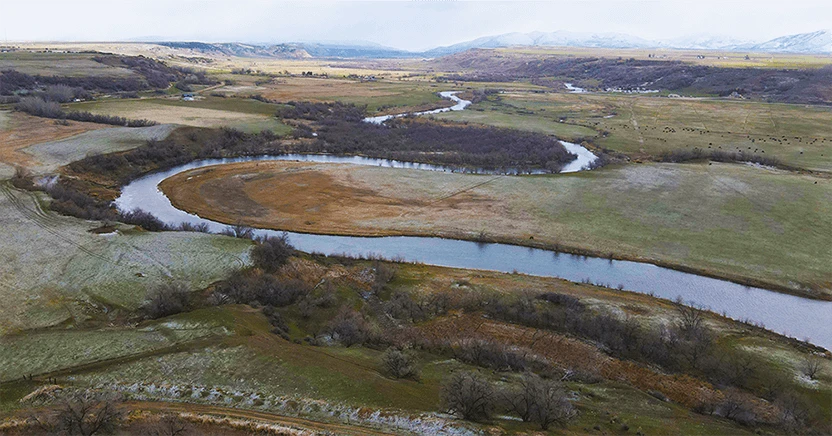
WUDA OGWA WATER AND HABITAT ECO-RESTORATION PROJECT, Idaho, U.S.
Creating a more natural stream channel, which will improve a mile of habitat along the existing waterway.
In the coming years, we plan to work with partners on long-term water restoration projects in our other priority water-stressed areas around the world.
Responding to Water Challenges Through Innovation and Partnerships
How is P&G enabling consumers to reduce their water footprint?
Together with our brands, we will continue to create and share products, tools, and information to help our consumers use less water at home, because we know that small actions at home can make a world of difference for our planet. We’re innovating to create products and campaigns that help people become more water efficient at home. We are focused on developing innovations that deliver irresistible superiority in a sustainable way, including:
- Cascade is helping to reduce daily water use in households across the U.S. by encouraging people to skip pre-rinsing dishes and instead run the dishwasher every night. Contrary to popular belief, the dishwasher uses four gallons of water per cycle, while the sink can use that same amount in just two minutes. And with an innovative formula containing enzymes that latch on to and break down food particles, Cascade Platinum gives consumers a superior clean without the pre-wash3. By skipping the sink with Cascade and choosing the dishwasher, households can save up to 100 gallons of water per week4. Cascade joined the Change the Course initiative to support several water restoration projects in the U.S. Over their lifetime, these projects are expected to restore nearly 2 billion gallons of freshwater in water-stressed regions.
- Swiffer Wet Jet can save households 70 gallons of water a year, versus using a traditional mop and bucket.
- Dawn Powerwash Dish Spray uses spray-activated suds to eliminate the need for water when hand washing dishes until the final rinse – cutting the amount of water used compared to traditional dish soaps by up to 50%.
- Pantene and Rejoice have developed No Rinse Conditioners that enable people to condition and nourish their hair without the need for water. Thanks to its light and fast absorbing formula, this new conditioning offering is applied outside of the shower on damp or dry hair, leaving hair more manageable and softer to the touch so it can be dried and styled as usual.
- Fairy's brilliant cleaning delivers excellent results, without pre-washing. By skipping the pre-wash by hand before using the dishwasher, households can save up to 12 liters of water per 2 minutes on average.
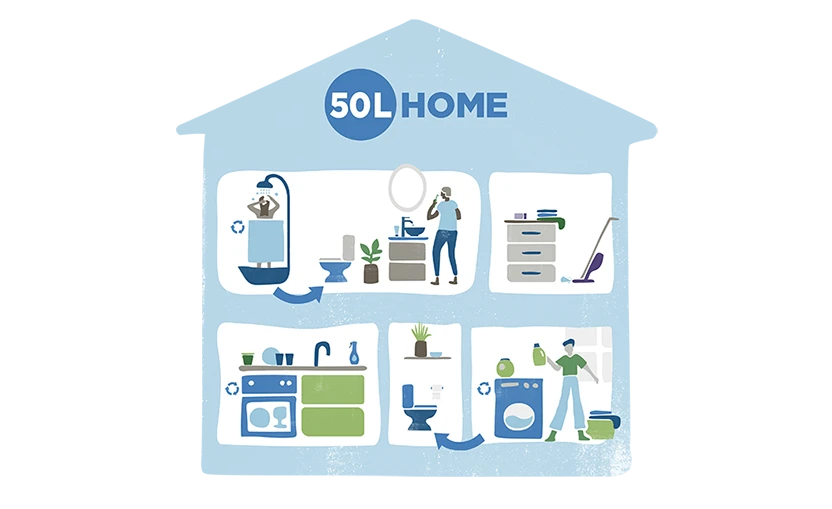
P&G is also developing partnerships to unlock new solutions to address water challenges, such as the 50LH Coalition. By helping people reduce hot water use without trade-offs, the Coalition is creating more efficient homes that can use 10 times less water than most use today. In the 50LH Coalition, we aim to reinvent the future of urban water use through innovations that reduce carbon emissions and promote water security for all.

P&G is also committed to improving access to clean drinking water for people in need around the world through our Children’s Safe Drinking Water Program (CSDW). The program provides a simple water purification packet that can clean 10 liters of water in just 30 minutes. P&G manufactures the P&G Purifier of Water packets and distributes them with the help of our more than 150 non-profit partners around the world. These organizations provide packets to rural areas where communities lack access to clean drinking water, and in times of natural disaster or other emergencies. CSDW has provided more than 19 billion liters of clean water to people in need in more than 90 countries around the world.
Reducing Water in Our Operations
How do P&G facilities optimize their water usage and reduce the amount of water needed to manufacture P&G products?
We’re continuing to set ambitious targets to make our facilities and manufacturing plants more water efficient:
- Reduce water use at our manufacturing facilities by 35% per unit of production by 2030, compared to a 2010 baseline.
- Recycle five billion liters of water every year by 2030.
We’ve already made significant progress toward our goals – with the help of our 138 facilities in 39 countries around the world, we increased water efficiency by 25% (vs. 2010), and we recycled and reused 3.1 billion liters of water in 2021 alone.
P&G is also a member of the Alliance for Water Stewardship, and we are committed to playing our part in protecting the water resources we share with our neighbors. All P&G sites located in high water-stressed areas are required to understand their local water sheds, create action plans, and address the key challenges impacting our operations and the local communities where we operate.
All of our plants around the world are also developing on-site water efficiency solutions. For example, our Feminine Care plant in Hungary uses innovative water treatment technologies to recycle 90% of its daily water demand, equal to more than 230 million liters of recycled water per year.
Where We Go from Here
While there is no simple solution for the world’s water crisis, we are determined to address shared water challenges within water-stressed areas where we work because we know it is where we can make the biggest difference. Our strategy will continue to evolve alongside our understanding of all the complex issues facing the world’s water resources. We will also continue to support a wide range of partners to amplify impact and accelerate simple solutions to help build a water positive future for all.For more information and ongoing updates about our commitments and progress, please see our Water Positive Future Strategy, ESG Investor Portal, and 2021 Citizenship Report.
1 Water that evaporates during the manufacturing of our products or is incorporated into the finished product manufactured at these sites.
2 Water from household leaks and evaporation during the use of our products.
3 50% more cleaning ingredients v. Cascade Complete ActionPacsTM.
4 With Energy Star certified dishwasher vs. washing dishes at a running sink for 11 minutes per day.
